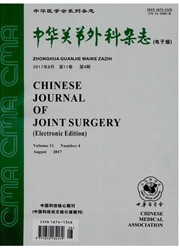

 中文摘要:
中文摘要:
目的探讨人工全髋关节置换术后股骨偏心距对行走过程中术侧下肢步态时间距离参数的影响。方法按入组标准对2000年1月—2005年12月于我院行单侧人工全髋关节置换术后患者29例58髋进行标准骨盆正位X线片检查,测量双侧股骨偏心距,计算股骨偏心距比(femoraloffsetratio,FOR)。行三维步态分析,采集步态时间距离参数。根据FOR分组并对双侧下肢的各项数据进行统计学分析。结果手术侧FOR小于对侧为A组,共10例,手术侧单腿站立相、踏步时间及跨距与对侧比较,差异有统计学意义(P〈0.05);分别对双侧下肢的步频、步速、跨步时间、踏步距离及双腿支撑时间进行比较,差异无统计学意义(P〉0.05);手术侧FOR大于对侧为B组,共19例,双侧下肢各项步态时间距离参数差异均无统计学意义(P〉0.05)。结论人工全髋关节置换术后术侧股骨偏心距不足对患者步态具有重要影响;人工全髋关节置换术中重建股骨偏心距有助于髋关节生物力学的恢复和术后步态的改善。
 英文摘要:
英文摘要:
Objective To investigate the effect of femoral offset ratio on gait temporospatial variables of operative side of lower extremity in walking after total hip arthroplasty (THA). Methods According to the inclusion criteria, 29 patients (58 hips) of unilateral THA in our hospital were selected. Femoral offset ratio (FOR) were calculated by measuring the femoral offset of the bilateral hips through standard pelvis AP X-ray . The temporospatial variables were measured by three-dimensional gait analysis, and then were compared statistically between the operative and the opposite sides in both groups which divided by FOR. Results There were 10 patients in group A whose FOR of operative sides were smaller than the opposite sides, and the other 19 patients whose FOR vice versa in group B. In group A, the differences of single leg support time, step time and stride length between both sides had statistical significance (P 0.05), while there were no statistical differences of stride frequency, gait velocity, stride time, step distance and double legs support time between both sides (P 0.05). In group B, no statistical differences of temporospatial variables were found between both sides (P 0.05). Conclusion The reduction of femoral offset of operative side has a serious effect on the gait after THA, and the construction of femoral offset should be helpful for the biomechanical rehabilitation of hip joint and the improvement of postoperative gait.
 同期刊论文项目
同期刊论文项目
 同项目期刊论文
同项目期刊论文
 Interferon alpha enhances etoposide-induced apoptosis in human osteosarcoma U20S cells by a p53-depe
Interferon alpha enhances etoposide-induced apoptosis in human osteosarcoma U20S cells by a p53-depe Autologous nucleus pulposus transplantation to lumbar 5 dorsal root ganglion after epineurium discis
Autologous nucleus pulposus transplantation to lumbar 5 dorsal root ganglion after epineurium discis Resistin Induces Expression of Proinflammatory Cytokines and Chemokines in Human Articular Chondrocy
Resistin Induces Expression of Proinflammatory Cytokines and Chemokines in Human Articular Chondrocy Upward and inward displacements of the acetabular component increase stress on femoral head in singl
Upward and inward displacements of the acetabular component increase stress on femoral head in singl Sinomenine suppresses expression of interleukin-1beta-induced matrix metalloproteinases in human ost
Sinomenine suppresses expression of interleukin-1beta-induced matrix metalloproteinases in human ost p14ARF sensitizes human osteosarcoma cells to cisplatin-induced apoptosis in a p53-independent manne
p14ARF sensitizes human osteosarcoma cells to cisplatin-induced apoptosis in a p53-independent manne Interferon-alpha enhances sensitivity of human osteosarcoma U2OS cells to doxorubicin by p53-depende
Interferon-alpha enhances sensitivity of human osteosarcoma U2OS cells to doxorubicin by p53-depende 期刊信息
期刊信息
